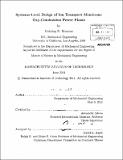| dc.contributor.advisor | Alexander Mitsos. | en_US |
| dc.contributor.author | Mancini, Nicholas D. (Nicholas David) | en_US |
| dc.contributor.other | Massachusetts Institute of Technology. Dept. of Mechanical Engineering. | en_US |
| dc.date.accessioned | 2011-12-19T18:52:33Z | |
| dc.date.available | 2011-12-19T18:52:33Z | |
| dc.date.copyright | 2011 | en_US |
| dc.date.issued | 2011 | en_US |
| dc.identifier.uri | http://hdl.handle.net/1721.1/67797 | |
| dc.description | Thesis (S.M.)--Massachusetts Institute of Technology, Dept. of Mechanical Engineering, 2011. | en_US |
| dc.description | Cataloged from PDF version of thesis. | en_US |
| dc.description | Includes bibliographical references (p. 187-192). | en_US |
| dc.description.abstract | Oxy-fuel combustion, particularly using an integrated oxygen ion transport membrane (ITM), is a thermodynamically attractive concept that seeks to mitigate the penalties associated with CO 2 capture from power plants. Oxygen separation in an ITM system consists of many distinct physical processes, ranging from complex electrochemical and thermochemical reactions to conventional heat and mass transfer. The dependence of ITM performance on power cycle operating conditions and system integration schemes must be captured in order to conduct meaningful process flow and optimization analyses. An axially spatially-distributed, quasi two-dimensional ITM model is developed based on fundamental conservation equations, semi-empirical oxygen transport equations obtained from the literature, and simplified fuel oxidation kinetic mechanisms. Aspects of reactor engineering such as geometric structure, flow configuration and the relationship between oxygen transport, fuel conversion and pressure drop are explored. Emphasis is placed on model robustness, modularity, and low computational expense. The model seeks to bridge the gap between detailed CFD studies and overly-simplified black-box models and provides a tool for the analysis and design of ITM systems. The ITM model is used to explore the dependence of ITM performance on reactor geometric structure, flow configuration, operating conditions, membrane material properties, and uncertainty in key modeling assumptions. Many operational constraints are presented that are usually overlooked by black-box modeling strategies, and the implications of these constraints are explored. Further, a comparison is made between reactive and separation-only ITMs to assess the relative merits and disadvantages of each. The results show that although a reactive ITM significantly improves the partial pressure driving force, practical reactor engineering considerations indicate that this concept is not superior to counter-current separation-only ITMs, mainly due to stringent temperature limitations of the membrane material. A Second Law assessment of certain ITM configurations is performed to evaluate the potential of ITM technology to reduce the air separation penalty and to guide effective systems-level integration. Finally, simulations of various ITM-based zero-emissions power cycles using the intermediate fidelity ITM model are performed. The first objective is to analyze the prevalent ITM-based power cycle designs and develop novel design modifications. The second objective is to investigate the effect of reactive ITM improvement design strategies proposed herein, such as the multiple compartment reactive ITM (MCRI), the low activation energy (LAE) materials reactive ITM, and hybrid reactive and separation-only concepts. An assessment of the potential for these novel ITM designs to reduce both the penalty and size associated with ITM air separation technology is conducted. The power cycle simulation and analysis clearly demonstrates the various challenges associated with implementing reactive ITMs. The hybrid cycle displays the potential to reduce the size of the ITM compared to the best separation-only concept while maintaining a comparable First Law efficiency. Additionally, the MCRI simulation results indicate comparable ITM size and pressure drops to the best separation only-concepts, greatly improving the attractiveness of reactive ITMs. Overall, the work herein finally allows for detailed optimization analyses to determine the best possible ITM oxy-combustion power cycles. | en_US |
| dc.description.statementofresponsibility | by Nicholas D. Mancini. | en_US |
| dc.format.extent | 192 p. | en_US |
| dc.language.iso | eng | en_US |
| dc.publisher | Massachusetts Institute of Technology | en_US |
| dc.rights | M.I.T. theses are protected by
copyright. They may be viewed from this source for any purpose, but
reproduction or distribution in any format is prohibited without written
permission. See provided URL for inquiries about permission. | en_US |
| dc.rights.uri | http://dspace.mit.edu/handle/1721.1/7582 | en_US |
| dc.subject | Mechanical Engineering. | en_US |
| dc.title | Systems-level design of ion transport membrane oxy-combustion power plants | en_US |
| dc.type | Thesis | en_US |
| dc.description.degree | S.M. | en_US |
| dc.contributor.department | Massachusetts Institute of Technology. Department of Mechanical Engineering | |
| dc.identifier.oclc | 767826296 | en_US |
